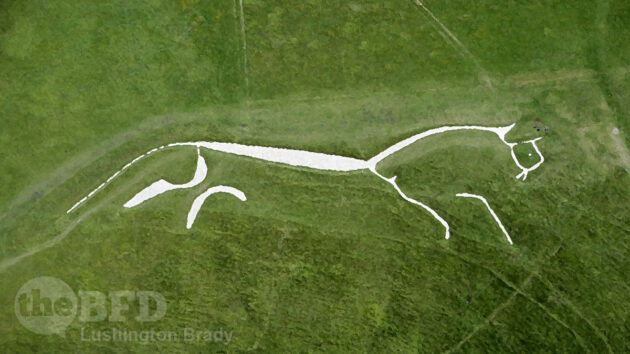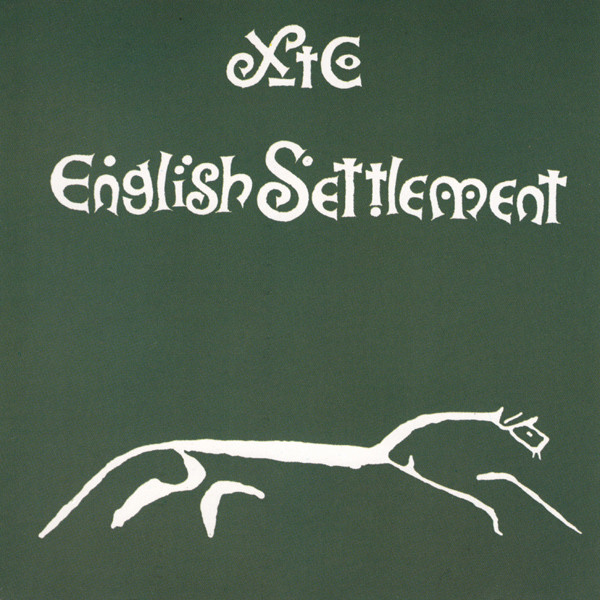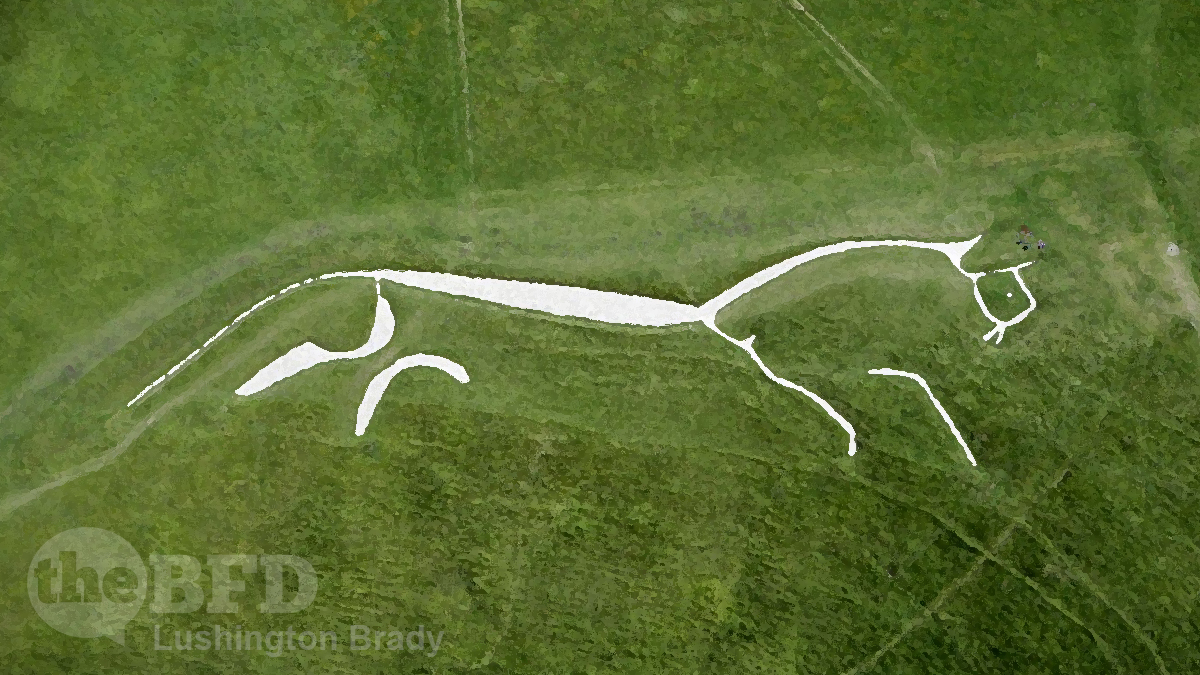Some time back, The BFD reported on recent archaeological research on Britain’s Cerne Abbas Giant. The Giant is one of the most famous example of a geoglyph, massive figures carved into the chalk hillsides of southern England.
As recent studies indicate, the Giant is much older than supposed. Previously, it was believed that the Giant dated from the 17th century. Using a technique called Optically Stimulated Luminescence (OSL), it has now been shown that the Giant dates to the Anglo-Saxon period, around 700 AD.
Similar techniques have been used to date perhaps the most famous of all of Britain’s geoglyphs.

Every December, observers standing on Dragon Hill in Oxfordshire can watch a spellbinding spectacle unfold. The sun rises behind the Uffington White Horse, a 360-foot-long chalk geoglyph that seems to gallop across a hillside toward an Iron Age fort. Because of its low trajectory in midwinter, the sun then “appears to roll over the body of the horse [on the horizon] and make a gentle arc in the sky,” says Joshua Pollard, an archaeologist at the University of Southampton.
For centuries, no one had any idea when people created this or many other mysterious geoglyphs, nor what they might represent. Yet generation after generation has painstakingly maintained them. If chalk figures aren’t weeded and rechalked, they grass over in about 20 years.
Such overgrowth is why the Cerne Abbas Giant was mistakenly dated to the 17th century. Meticulous English cartographer John Nordern made no mention of the giant in his 1617 survey of the area. So it was assumed that the Giant didn’t then exist. Instead, it appears that it had merely become overgrown with grass.
Using the OSL technique, scientists are able to calculate when a soil sample last absorbed the sun’s rays. Applying the technique to the deepest layers of the Uffington White Horse led to an astonishing conclusion.
The White Horse’s deepest layers last saw sunlight between 1380 B.C. and 550 B.C.
At around 3,000 years old, the Uffington White Horse is by far Britain’s oldest dated chalk geoglyph. Archaeologists believe Bronze Age farmers used deer antlers and wooden shovels to scour the steed out of the turf.
Why did prehistoric Britons undertake such a laborious task?
Pollard thinks the geoglyph is a sun horse—a common creature in ancient Indo-European cosmology that carries the sun across the sky like a chariot. The figure may have been the focus of winter-solstice celebrations.
The surrounding area is dotted with other prehistoric relics. A couple of kilometres away is the Blowing Stone, a perforated sarsen stone which produces a booming sound if blown through correctly. Also nearby is the neolithic barrow and tomb, Wayland’s Smithy. The barrow sits next to the Ridgeway, Britain’s oldest road, which has been used for at least 5,000 years.
The White Horse is regularly scoured by National Trust volunteers. About 60 historically documented geoglyphs have disappeared. Britain’s other remaining chalk giants — newcomers, all, compared to the horse — have regularly disappeared and reappeared, and been altered, like giant chalkboards.
Many of the more recent chalk giants date from the 1500s, a period of upheaval in England that encompassed the Reformation and the English Civil War. It is thought that many of these later geoglyphs are linked to patriotic mythology.
The Long Man of Wilmington—a 235-foot-tall chalk man holding a staff in each hand—may be one such symbol. In 2003, OSL dated the figure to roughly A.D. 1545, prompting archaeologist Martin Bell, from the University of Reading, to theorize that the Long Man represents a mythical giant.
“During that period, there was a big mythology about the role of giants in Britain’s origin myth,” Bell says. “That led to giants being depicted in other [chalk] hill figures, which are described in historical documents but which have now vanished.” According to these legends, giants were the original rulers of Albion—an ancient name for Britain that may mean “white land” and refer to the chalky geology[…]
Allen’s analysis suggests that, at various times, the geoglyph may have been overgrown with plants, perhaps intentionally. “There may be some periods in British history where people felt seeing a naked man on the hillside wasn’t appropriate for young women or for society,” he says.
People have been chalking, rechalking, and changing the giant for centuries, so the archaeological material at the hillside runs deep, Papworth says. Evidence shows the figure may have once held a cloak and a severed head, and was emasculated and remasculated in Victorian times. More recently, it received a COVID-appropriate face mask.
The Atlantic
So, rather than a single creative act, many of the chalk giants seem to be a kind of community noticeboard etched into the landscape. For centuries, even thousands of years, the chalk giants represent a tradition that connects generations of Britons.

Please share this article so that others can discover The BFD

